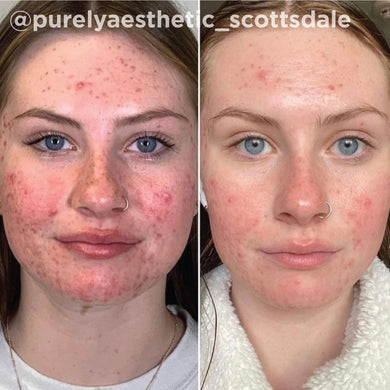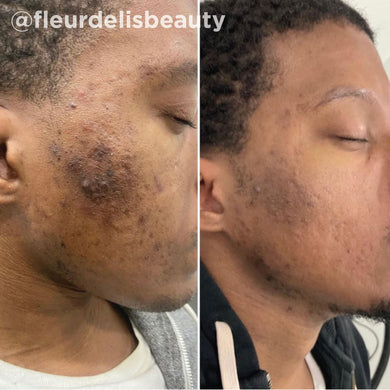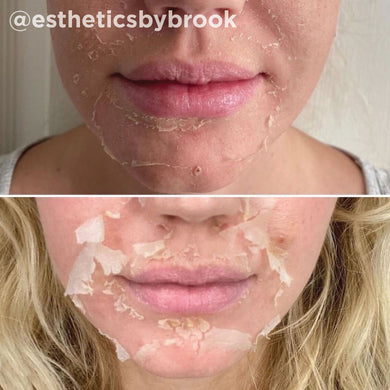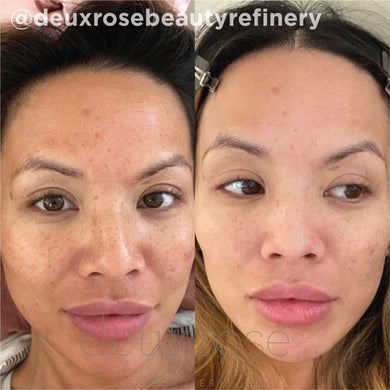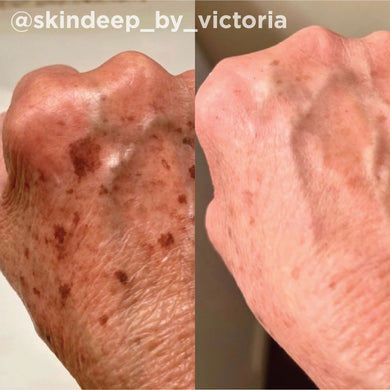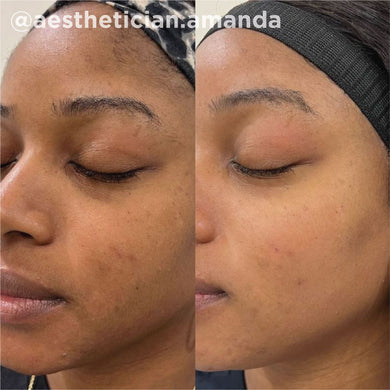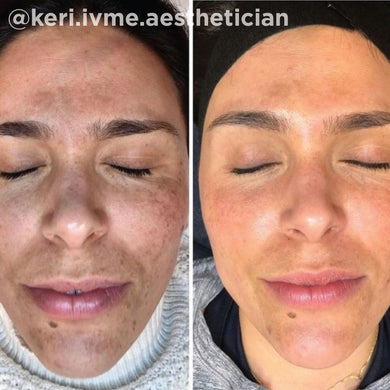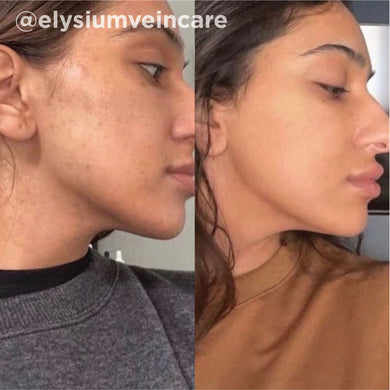Post-Treatment Tips
Peels and lasers and microneedling—oh my! When it comes to in-office facial treatments, the choices are anything but sparce, but the results all lead to one incredible place: skin that feels smoother and looks fresher, meaning you’re suddenly *very* willing to go filter-free in that next selfie.
Before you start snapping pics, there are a few steps you must take to ensure recovery with post-treatment aftercare. Why? Because in-office treatments are a little like working a muscle: you have to create a bit of trauma to see bigger results from the muscle, and in the skin, you have to create a little trauma to see results—and in both situations, results are so much better when your recovery game is on point. Here, we break down the most popular in-office facial treatments—from benefits to what you can expect, and the best post-treatment aftercare that will leave you refreshed (sneak peek: all recovery should include VI Derm Post-Treatment Repair Cream—but more on that later).
What is a chemical peel?
A chemical peel is the application of a solution, such as alpha hydroxy acid, beta hydroxy acid or trichloroacetic acid. They range in in intensity from low-grade (or light) with minimal downtime to aggressive (or deep). The lighter the chemical peel, the more frequently they can be performed. The more aggressive, the more side effects and length of recovery time one can expect, though the reward may be greater.
How do chemical peels work?
A chemical peel stimulates exfoliation to remove the outer-most layers of skin. Our skin exfoliates naturally (in fact, you’re shedding a ton of old skin cells as you read this), but as we age, that exfoliation process (aka, cell turnover) slows and old cells are slower to fall away. Exfoliation instigates your body’s cell turnover process to encourage new cells to the surface, and those cells are fresher, plumper, and help give skin a noticeable smoothness.
What skin type are chemical peels best for?
A chemical peel is best suited for helping skin shed stubborn discoloration, hyperpigmentation, uneven skin tone, and post-acne scarring, as well as stimulating new collagen production. Chemical peels can help with the look of wrinkles, as they lift away dead skin cells that an make a wrinkle look more intense. Though a chemical peel may not completely resolve sagging skin issues, it can help tighten the look of skin due to new collagen production.
What are some potential chemical peel side effects?
Chemical peel side effects can include anything from flushing during treatment to sustained redness after the treatment, swelling, crusting, and peeling. (NEVER pick scabs or skin that begins peeling, as this could cause intense pain and permanent skin damage.) A chemical peel for darker skin tones may experience darkening or lightening of the skin, which is why a chemical peel should only be performed by a dermatological professional who has a thorough understanding of skin care products and the Fitzpatrick skin types. In addition, you can opt to get a chemical peel that is proven safe and effective for darker skin tones, like the VI Peel, the world’s first painless and skin tone inclusive medium-depth chemical peel.
What’s the best post-treatment aftercare routine for chemical peels?
- Soothe, soothe, soothe! Ask your dermatologist to recommend a professional-grade, super-soothing balm with 1% Hydrocortisone and anti-inflammatory ingredients like Ginger Extract, as well as hydrating ingredients like Glycerin for soothing skin irritation. Our top pick? VI Derm Post-Treatment Repair Cream that’s not only within your skin care budget, but is proven to visibly reduce redness and blotchiness in 2 days.*
- We can’t say it enough: SPF is your BFF. Your barrier is trying to renew itself and needs all the defense it can get against damaging UV light. Reach for a gentle, hydrating medical-grade SPF, like VI Derm SPF 50 Daily UV Defense Broad Spectrum Sunscreen.
- Follow a gentle skin care routine that includes fragrance free cleansers and moisturizers. Wash your face with cool water, not hot, as it can help with soothing skin irritation and tempering redness.
- Moisturize. A chemical peel can be drying, and moisture will help keep skin balanced. Moisturizing can also help comfort and soothe during reparative peeling stage.
- Don’t do anything that builds heat in the body, from steam rooms to intense exercise.
- Don’t exfoliate.
- Reach out to your dermatologist if you have any issues, concerns, or pain.
What is laser resurfacing and how does it work?
There are two types of laser resurfacing: ablative lasers are a form of exfoliation that precisely removes layers of skin to stimulate new cells to the surface, and nonablative lasers, or non-exfoliating lasers (such as IPL) work by heating skin tissue to stimulate collagen formation without any kind of skin removal.
What skin type is laser resurfacing best for?
People looking to soften wrinkles, lessen discoloration, and reboot younger-looking skin. Lasers can also help with acne and mild post-acne scarring. To determine which laser resurfacing treatment is best for your skin care concerns, speak with a dermatologist. And, be sure to disclose any medical information, if you’ve taken acne medication, if you’re prone to cold sores or breakouts, or are prone to scarring.
What are some potential laser resurfacing side effects?
Nonablative laser resurfacing isn’t as invasive, meaning there should be fewer side effects; however, this does mean nonablative laser resurfacing isn’t as effective as ablative lasers and that is something you should discuss with your dermatologist before treatment. Ablative laser resurfacing can trigger anything from mild redness to swelling, itching and scarring. In melanin-rich skin tones, chances of hyperpigmentation or hypopigmentation can happen.
What’s the best post-treatment aftercare routine for laser resurfaced skin?
- After your nonablative laser resurfacing treatment, it’s highly likely that you can return to your regular skin care routine immediately.
-
Post-ablative laser resurfacing treatments may include a gentle and minimal skincare regimen that is free of any potentially irritating ingredients. Your dermatologist may also recommended an ointment or balm to use 3-5 days AFTER treatment to help in reducing inflammation, soothing skin irritation, and expediting the healing process, such as VI Derm Post-Treatment Repair Cream.
What is microneedling?
It’s best to start with what microneedling isn’t, and that’s to say it is not the same as an at-home manual dermal roller. While both dermal rollers and microneedling work on the same principle (tiny needles entering the skin to stimulate collagen production), microneedling is more sanitary, the results are more consistent, and there’s less risk of errors that could damage your skin.
How does microneedling work?
After a numbing agent is applied, your skin care professional will sweep a motorized hand-held tool over areas of your face as sterilized needles penetrate the skin, creating safe and controlled microinjuries to the skin to encourage collagen production. The needles penetrate at different depths depending on the area of the skin or the desired treatment benefit.
What skin type is microneedling best for?
Microneedling is a non-surgical procedure that’s great for anyone concerned with the signs of aging or wants to bring back a youthful plumpness and glow, uneven tone and hyperpigmentation, uneven texture like acne scarring or post-acne scarring. Microneedling can even help with stubborn stretchmarks. Another advantage? There’s no heat involved so those with melasma or potential for hyperpigmentation can undergo microneedling while lowering the risk of pigmenting. Microneedling is NOT recommended for patients with an active skin infection or keloid scarring.
What are some potential microneedling side effects?
Minor skin irritation, sensitivity to touch at the site of treatment, redness, and bruising are all normal after microneedling. Bleeding and infections can also occur, and in that case, contact your doctor immediately for additional care.
What’s the best microneedling aftercare routine?
- Microneedling post-recovery is all about babying your skin. Ask your dermatologist to recommend a balm for soothing skin irritation like VI Derm Post-Treatment Repair Cream to use 2 days AFTER treatment to help speed up the skin’s recovery process.
- Keep skin clean with a gentle cleanser and cool/tepid water.
- Don’t rub your face dry after cleansing—gently pat.
- Your dermatologist may advise against wearing makeup for a short period of time.
- A medical-grade sunscreen should be applied immediately after your microneedling treatment. Continue to wear and reapply sunscreen every day regardless of your exposure to the sun. Our top pick is VI Derm SPF 50 Daily UV Defense Broad Spectrum Sunscreen.
- Your dermatologist will have advice on whether you can continue to engage in strenuous exercise or go swimming
What is Botox and how does Botox work?
Botox is an injection that works beyond the skin’s surface to relax facial muscles by blocking nerve signals. Botox is a neurotoxin; the word neuro refers to the nervous system. Botox is primarily injected into areas where repeated muscle movement from facial expressions has gradually impacted the skin to create a wrinkle, such as corners of the eyes, glabella lines (between-the-brow furrows), and the forehead.
What skin type is Botox best for?
Botox is best for any skin type showing fine lines or deep wrinkles. It’s also ideal for people who experience excessive sweating or suffer from migraines, but you should always speak to your physician or dermatologist if you’re seeking Botox for benefits outside of wrinkle correction.
What are some potential Botox side effects?
Botox in the hands of a certified skin care professional will always help mitigate side effects. However, if you have any of the following, you should immediately contact your dermatologist: flu-like symptoms, vision problems and breathing problems. Before your treatment, speak with your dermatologist about all the potential Botox side effects so you’re well informed. Botox is not generally recommended for those who are pregnant or breastfeeding.
What’s the best Botox post-treatment aftercare routine?
- The Botox post-treatment aftercare routine is very straightforward: continue on with your regular skin care routine and minimize rubbing or excessive touching of the face in the first 24 hours to prevent the treatment from spreading.
- If you feel like your skin needs extra attention and soothing, ask for a post-recovery treatment balm like VI Derm Post-Treatment Repair Cream.
References for this article:
*Based on a 3rd party study of Bisabolol and Zingiber Officinale (Ginger) Root Extract on skin irritation.
https://www.mayoclinic.org/tests-procedures/chemical-peel/about/pac-20393473
https://www.mayoclinic.org/tests-procedures/laser-resurfacing/about/pac-20385114
https://www.yalemedicine.org/conditions/microneedling
https://www.mayoclinic.org/tests-procedures/botox/about/pac-20384658
